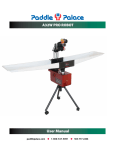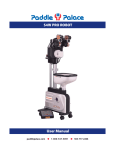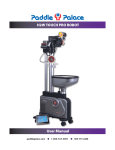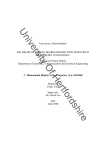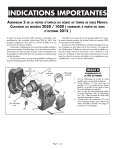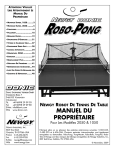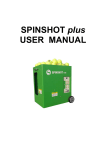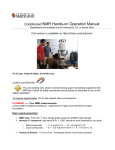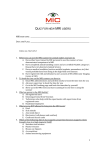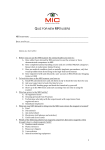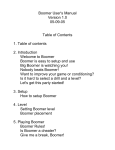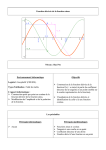Download User Manual - Paddle Palace
Transcript
G2W PRO ROBOT User Manual paddlepalace.com 1-800-547-5891 503-777-2266 Putting Robot Technology to Work for You The Paddle Palace G2W Pro robot is everything you need in a robot! This robot has two throw wheels with independently programmed motors, allowing a great variety and degree of spins, including topspin, underspin, sidespin, and no-spin. Plus, a new technological advancement allows the robot to shoot consecutive shots with different spins. You can program your own sequences including 11 landing spots with combinations of short and long balls. Or, you can choose from 30 pre-programmed sequences which have combinations of spins, short and long balls, and with a variety of landing spots. The remote control box can be set on the player’s side of the table, and it controls all functions of the robot, including the movement of the robot head up or down for higher or lower balls, and rotating the head for topspin, underspin, and sidespin. The G2W is designed for the player who wants a high-quality long-lasting robot that is easy to use, yet offers the sophisticated technology for practicing the ideal training patterns to take your game to the next level. Go to paddlepalace.com to find out more. Two throw wheels New technological advancement allows robot to throw different spins on consecutive shots Program your own sequences including 11 landing spots and short and long balls Includes 30 programmed sequences with combinations of topspin, underspin, sidespin, no spin, long balls, short balls, and with a variety of landing spots Remote control box on players side of table for all settings, including ball trajectory Random sequence mode shoots topspin, underspin, sidespin, short and long balls, to random landing spots Memory function saves current settings for next practice session Ball recycling and net collection system Easy set up, and rolls from table for convenient storage PADDLE PALACE ROBOTS INCLUDE: Free 120 Nittaku Balls Free Ball Pick-up Net Free Robot Training DVD Free shipping to contiguous USA Item OPVG2 30-day money-back Guarantee One year limited Warranty Paddle Palace G2W Robot User Manual Table of Contents 4 Robot Components / Features 5 How to Assemble the Ball Catch Net 5 The Power Supply 6 Control Box Features 6 Setting Ball Counter 6 Setting the Frequency 7 Setting the Head Angle (Loop) 7 Setting the Type of Spin (Head Rotation) 8 Setting Throw Wheel Speed 8 Selecting Irregular Rotation 8 Selecting Pre-Programmed Landing Spot Location Sequences (Various Serving Sequence) 9 Selecting the Landing Spot Locations (Program Your Own Sequence) 9 Setting Shooting Head Serve 9 Adjusting the Volume 10 How to Maintain Your New Robot 10 Quick Start Guide 11 General Warning/Safety Issues 11 Trouble-Shooting 12 30 Pre-Programmed Landing Spot Location Sequences paddlepalace.com 1-800-547-5891 503-777-2266 page 3 Paddle Palace G2W Robot page 4 User Manual PADDLE PALACE G2W PRO ROBOT Robot Components / Features This manual has been written to help you enjoy and get the most out of your new Paddle Palace Robot. Take time to read these pages thoroughly and keep it handy for reference when using your robot. 1. Top Throw Wheel 2. Shooting Head 3. Bottom Throw Wheel 4. Net Support Connector 7a. Ball Container [top view] Poke Bar 7. Ball Container The capacity of the Ball Container is 100, 40mm balls. The container should not be filled above the yellow line inside the container. Anything other than table tennis balls in the Ball Container may damage parts and adversely affect the robot’s normal operation. 5. Power Switch 6. Control Box 8. Control Box Support Bracket 9. Ball Catch Net page 5 Paddle Palace G2W Robot User Manual How to Assemble the Ball Catch Net Net Hardware: A A 2 Net Supports that clamp on either side of table B Control Box Support Bracket B 1. Unlock the buckle that holds the two halves of the Ball Catch Net together. 2. Partially unfold the Ball Catch Net and carefully slip it over the robot head. Insert the double pin into the net support connector located on the robot frame. 3. Open and spread out both sides of the net. 4. Always unlock the robot wheels before moving the robot. Roll the robot to the table. Ball Catch Net assembly is the same on both G2W and S4W models. [S4W shown in photo] 5. Slip the sleeves of the ball net over the net support clamps. 6. Clamp net supports to the table near the net and slip the elastic band over the net support knob. 7. To store the robot, fold the Ball Catch Net and lock the buckles. Unlock the wheels and roll the robot away. The Power Supply The robot is powered by standard US home current (120V). Make sure the power cord is securely plugged in. The on/off switch is located on the backside of the robot. Turn off and unplug the robot when not in use. page 6 Paddle Palace G2W Robot User Manual G2W Control Box Adjustment Keys Decrease Keys Increase Keys Digital Display Top Wheel Speed [Left to Right] Ball Counter, Volume, Spin, Various Serving Sequences Irregular Rotation Bottom Wheel Speed Frequency Serving Curve Loop START/PAUSE Short Ball Set Landing Spot Landing Spot Locations [11 Positions] Setting Ball Counter Press the Ball Counter button to set the number of balls the robot will put in play. You can select any number of balls from 1 to 999 by using the “Up” and “Down” arrows of the adjustment buttons. Holding either the “Up” or “Down” arrows will fast forward the ball count. Once the robot has started, the ball counter begins counting down. When the number reaches 0, the robot stops and returns to standby mode. Ball Counter Setting the Frequency The ball frequency (number of balls per minute the robot will put into play) can be adjusted in the standby or working mode. Press the Frequency (+) button to increase or Frequency (-) button to decrease frequency. The frequency control feature has 10 settings. The slowest setting (1) produces approximately 25 balls per minute, while the fastest setting (10) produces approximately 95 balls per minute. page 7 Paddle Palace G2W Robot User Manual Setting the Head Angle (Loop) The angle of the Shooting Head determines the arc of the ball’s flight. To adjust the Shooting Head’s angle, use the control feature labeled Serving Curve/Loop located on the control box. Pushing the “Up” arrow will raise the head, creating a high ball arc. Pushing the “Down” arrow will lower the arc of the ball’s flight path. Low curve makes landing spot short High curve makes landing spot long Setting the Type of Spin (Head Rotation) Spin By pushing the Spin button you will be able to choose one of the following 9 different spins: 1. top spin; 2. under spin; 3. no spin; 4. left side spin; 5. right side spin; 6. left-side top spin; 7. left-side under spin; 8. right-side top spin; and 9. right-side under spin. Pushing either the “Up” or “Down” arrows of the adjustment buttons will move you through each of the 9 spin choices. The speed of the head wheels will determine the amount of ball spin. Changing the speed of either head wheel and/or the arc of the shooting head will affect the ball flight and alter its landing spot. The wheel and arc adjustments add a significant variety of options to this “Spin” function. Spin is created by rotation of shooting head and speed adjustments. Use the Control Box to select your desired settings. The robot Shooting Wheels will automatically assume the correct positions, based on your settings. Head in straight position Head in rotated position Paddle Palace G2W Robot page 8 User Manual Setting the Throw Wheels Speed (Amount of Speed and Spin) Top and Bottom Wheel Speed Ball speed can be adjusted while the robot is in either the Working or Standby mode. The top and bottom wheel display will blink the current settings when the robot is in the standby mode. The wheel speeds are changed by pressing the “Increase” or “Decrease” buttons. The speeds of the top and bottom throw wheels determine the speed and amount of spin, or lack of spin, of the ball delivered. Each wheel has 10 settings. The higher the setting, the faster the ball speed becomes. The ball speed is roughly proportional to the strength of spin. To produce topspin, the top wheel is set at a higher number than the bottom wheel. To produce under spin the bottom wheel is set higher than the top wheel. Less or no spin is produced when the wheel speeds are set closely together. Selecting Irregular Rotation Irregular Rotation The Irregular Rotation button is set in the Standby mode. By pushing the Irregular Rotation button you program the Shooting Head to move independently, clockwise and counterclockwise. The speed and spin settings are automatically pre-set when the Irregular Rotation function is selected. Once you have selected the Irregular Rotation function, you can then program a landing spot sequence to suit your training needs by selecting the “Landing Spot” button and following the directions as outlined in the “Selecting the Landing Spot” section of this manual (page 9). Selecting Pre-Programmed Sequences (Various Serving Sequence) Various Serving Sequence The Various Landing Sequence is set in the Standby mode. By pressing the Various Serving Sequence button, you can select one of the 30 numbered sets of pre-programmed sequences listed below. A red led light will come on when this feature is activated. Press the “Up” or “Down” arrow buttons until the number of your desired sequence shows in the display. See page 12 of this manual for 30 Pre-Programmed Sequences page 9 Paddle Palace G2W Robot User Manual Selecting the Landing Spot Locations (Program Your Own Sequence) Short Ball Set Landing Spot button Landing Spot Locations The Landing Spot Location Sequence is set in the Standby mode. The 11 numbered buttons on the bottom of the control box indicate 11 locations (landing spots) on the table where the robot will deliver balls. The blue area surrounding the buttons represents the receiving end of the table. To program a landing spot location sequence, first press the Landing Spot button. All of the 1-11 location lights will be off at this point. Press the Location Button for where you want the first ball of your sequence to land (for example press Location 3). The red LED light for that location (3) will come on. (If you want this or any other shot to be short, press the Short Ball button, otherwise the ball will be long.) Press another Location Button (8 for example). The second ball of your sequence will land at Location 8. Press 8 again and the third ball will land on Location 8. The number of balls that land on the same spot depends on how many times you press that Location Button. You have the option to choose a short ball after each time a location button is selected. When done, start the robot (Start Button). Your landing spot location sequence will play and repeat until the ball counter gets to zero. The robot memory function will remember the current settings next time you play. Setting Shooting Head Serve Ball Counter (+) Ball Counter 1. Set the Ball Counter of the shooting head to the number of balls you want to receive (from 1 to 999). Once the robot has started, the ball counter begins counting down. When the number reaches 0, the robot stops and returns to standby mode. 2. Set the Frequency press (+) to increase (-) to decrease. 3. Set the Head Angle (Loop) 4. Set the type of Spin (spin indication) 5. Set the Throw Wheel Speed (amount of speed and spin) 6. Set the Landing Spot Locations. 7. Press Start/Pause button to start robot Adjusting the Volume By pressing the Volume button you will have 9 different volume levels. The lowest level is 0 the highest is 9. When 0 is selected the volume is off. Volume Paddle Palace G2W Robot page 10 User Manual How to Maintain Your New Robot A B If a foreign object enters the ball container, turn off the power. A Open the moveable door cover to the view window, located on the motor side of the robot. B Unscrew the transparent guard plate, and remove the foreign object. ELECTRONICS: The robot’s electric components are located in the machine’s circuit board and the control box. Therefore, you should be careful to avoid dropping either component or avoid any activity that would cause damage to the internal electronic units of one or both of these components. MECHANICS: The robot’s mechanical components are located in the mechanisms that produce the ball service and delivery. Special attention should be paid so that no foreign objects are put into the ball container. Foreign objects will block the robot’s delivery wheel and result in damage to the robot. If a foreign object does enter the ball container, it can be retrieved by opening the moveable door cover to the view window located on the motor side of the robot. First, turn off the power, then open the moveable door cover, remove the transparent guard plate, and take out the foreign object. POKE BAR: When the poke bar inside the ball container Ball Container [top view] has worked for a long time, it should be checked for loose showing Poke Bar screws so as to prevent any trouble that would lead to an irregular ball delivery. FRICTION WHEELS: Under normal operation, and after long use, the top and bottom friction wheels may become dirty. To ensure a quality serve, please clean the wheels often with a wet towel. Always turn off the robot’s power before cleaning. Do not use force to move the shooting head. The friction wheels are able to work for 5,000 hours or longer before they need to be replaced. When performing the replacement, power off the robot, remove the protective cover and remove the screws from the friction wheels with a screwdriver. After replacing the wheels, replace the screws properly and with care. Quick Start Guide Use the Quick Start Guide on the bottom of the Control Box for a handy reference while using the robot. The robot has a memory function that will retain the current settings when the robot is turned off. Start/Pause: Power up robot, press “Start” after setting functions, press “Pause” if you need to make adjustments. Ball Quantity Counter: Press (+) to increase, press (-) to decrease. Frequency: Press (+) to increase, press (-) to decrease. Serving Curve/Loop: Press “Up” to raise the shooting head, the landing spot will become longer (ball will land closer to the table end). Press “Down” button to lower head (ball will land closer to the net). Type of Spin (Head Rotation): Press the “Spin” (head rotation) button. Press “Up” or “Down” buttons to choose the type of spin. There are 9 settings, producing 9 different spins. Throw Wheel Speed (Amount of Speed and Spin): Press (+) to increase or (-) to decrease throw wheel speed for top and bottom throw wheels. Irregular Rotation Selection: Press the “Irregular Rotation” button, the shooting head starts to rotate 180 degree and the spins become various. Various Landing Sequences (Pre-programmed Sequences): Pause robot. Press “Various Serving Sequences”. Press the “Up” or “Down” keys to choose between 30 different sets of serving sequences. Landing Spot Locations Selection: Pause the robot. Press “Landing Spot” button. Press “Landing Spot Location” button 1-11 to select landing spot, Press “Short Ball” button to shorten landing spot, otherwise the landing spot will be long. Continue select more landing spots. Volume Control: Pause the robot. Press the “Up” or “Down” buttons to set volume. Paddle Palace G2W Robot page 11 User Manual General Warnings 1. Please read the instruction manual carefully before using the robot, and follow the operation instructions. 2. Children should be supervised while operating the robot. 3. Avoid windy and/or rainy days when using outdoors. 4. Use care when connecting and disconnecting the ball collection net 5. When the robot is operating, do not open the movable door, and do not touch the shooting head or poke bar. 6. When the robot is operating, please keep away from the shooting head to avoid being hit with a ball. 7. If you observe something abnormal, such as some smoke coming from the robot, stop the robot and unplug it immediately. Repair must be performed by a qualified repair person. 8. Some places on the robot will heat up during operation. Please be careful and pay attention so as to avoid burning yourself. 9. Turn the power switch off and unplug the robot after use. Trouble-Shooting FAILURE CAUSE SOLUTION Robot doesn’t work The ball counter has reached 0 and the robot is in standby mode Press the Start Key The plug is not connected properly to the electrical outlet. Check the plug connected to the electrical outlet The key on the control box is not pressed. Press the switch until the number display The control box doesn’t work Replace control box The poke bar in ball container is loose Fasten the poke bar The ball duct is jammed by foreign object Clear away the foreign object (see page ???) The amount of balls in the container are not enough The amount should be 50 to 100 balls It takes time to transport the balls from container to shooting head Wait for a while The robot doesn’t work due to the improper operation of control box Turn power off. Wait 3 seconds, then start up again The cable connecting to motor is loose Connect it with the original method The thin film switch of the control box has been broken Replace the thin film switch on the surface of control box Dirt and wear on the top and bottom wheels after a period of time in operation Clean or replace the friction wheel The long and short ball sequence mode is selected. Cancel the long and short ball sequence mode The irregular rotation mode is selected Cancel the irregular rotation mode The shooting head is deflected by external force Restart the robot Robot works but does not release the balls Pressed key failure Landing spot is unstable page 12 Paddle Palace G2W Robot User Manual 30 Pre-Programmed Serving Sequences Easy (Set 1 to 10) 1. 2 short under spins to the #10 spot; then 2 long top spins to the #2 spot 2. 2 short under spins to #1 spot; 3 long top spins to #9 spot. 3. 2 short left-side under spins to the #11 spot; 3 long top spins at the #2 spot 4. 2 short right-side under spins to the #5 spot; 2 long top spins to the #1 spot. 5. 2 short left-side under spins to the #2 spot; 2 long top spins to the #11 spot. 6. 2 short right-side under spins to the #4 spot; 2 long top spins to the #10 spot. 7. 2 short left-side top spins to the #11 spot; 3 long top spins to the #2 spot. 8. 2 short right-side topspins to the #10 spot; 2 long top spin to the #1 spot. 9. 2 short left-side top spins to the #1 spot; 3 long top spins to the #10 spot. See page 8 for instructions on using this feature. 10. 2 short righ-side top spins to the #2 spot; 2 long top spins to the #1 spot. Normal (Set 11 – 20) 11. 2 short under spins to the #11 spot; 1 long under spin to the #2 spot; 2 long top spins to the #1 spot. 12. 1 short under spin to the #9 spot; 1 long under spin to the #1 spot; 2 long top spins to the #10 spot. 13. 2 short under spins to the #10 spot; 1 long top spin to the #2 spot; 1 long top spin to the #11 spot. 14. 1 short under spin to the #11 spot; 2 long under spins to the #1 spot; 2 long top spins to the #6 spot. 15. 1 long under spin to the #6 spot; 1 short under spin to the #11 spot; 3 long top spins to the #2 spot. 16. 2 short left-side under spins to the #11 spot; 1 long top spin to the #11 spot; 2 long top spins to the #1 spot. 17. 2 short right-side top spins to the #2 spot; 2 long top spins to the #11 spot; 1 long top spin to the #2 spot. 18. 2 short left-side top spins to the #11 spot; 3 long top spins to the #2 spot; 1 long top spin to the #11 spot. 19. 1 short right-side under spin to the #1 spot; 1 long under spin to the #10 spot; 2 long top spins to the #11 spot. 20. 1 long right-side under spin to the #2 spot; 1 long under spin to the #11 spot; 2 long top spins to the #3 spot. Hard (Set 21 – 30) 21. 1 short under spin to the #10 spot; 1 long under spin to the #1 spot; 1 long top spin to the #5 spot; 1 long top spin to the #11 spot. 22. 1 short under spin to the #1 spot; 1 long under spin to the #11 spot; 1 long top spin to the #1 spot; 1 long top spin to the #10 spot. 23. 1 short under spin to the #11 spot; 1 short under spin to the #7 spot; 1 long under spin to the #1 spot; 2 long top spins to the #9 spot. 24. 2 short under spins to he #2 spot; 1 long under spin to the #10 spot; 1 long top spin to the #11 spot; 1 long top spin to the #5 spot; 1 long top spin to the #1 spot. 25. 2 short left-side under spin to the #11 spot; 1 long under spin to the #2 spot; 2 long top spins to the #10 spot; 1 long top spin to the #6 spot. 26. 1 short left-side under spin to the #11 spot; 1 long under spin to the #2 spot; 2 long top spins to the #10 spot; 1 long top spin to the #6 spot. 27. 1 short left-side under spin to the #1 spot; 1 long under spin to the #2 spot; 1 long top spin to the #8 spot; 2 long top spins to the #11 spot. 28. 1 short right-side under spin to the #1 spot; 1 short under spin to the #11 spot; 1 long top spin to the #2 spot; 1 long top spin to the #10 spot. 29. 1 short left-side under spin to the #1 spot; 1 short under spin to the #9 spot; 1 long under spin to the #2 spot; 1 long top spin to the #3 spot; 1 long top spin to the #10 spot. 30. 2 short right-side under spins to the #10 spot; 2 short under spins to the #1 spot; 1 long under spin to the #9 spot; 1 long top spin to the #11 spot; 1 long top spin to the #2 spot. NOTE: X1, X2, X3 refers to how many balls shoot to a particular spot. #1, #2, etc., refers to the landing spots, ranging from #1 on far left to #11 on far right. 800-547-5891 503-777-2266 www.paddlepalace.com












